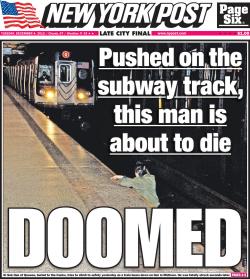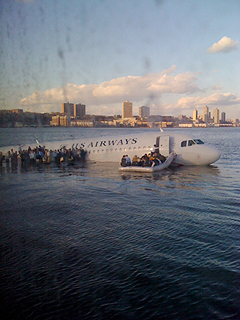In January 2009 when Chesley “Sully” Sullenberger splash landed a plane in the Hudson, the first picture to emerge was placed on Twitter. The photo was shot by Janis Krums, who was on a ferry that was first to reach the downed plane. At the time it was taken, neither he, nor anyone else, knew what kind of tragedy might await the passengers. Passengers stood on the wing with the icy waters beneath them.
Krums tweeted at the time:
“There’s a plane in the Hudson. I’m on the ferry going to pick up the people. Crazy.”
The WSJ wrote of the photographer, “Notch another win for citizen journalism,” and the Daily News called his 15 seconds of fame “well-deserved.”
Fast forward to this past week and another photo taken amidst a potential tragedy. Ki Suk Han was pushed onto the subway tracks as a train approached. R. Umar Abbasi snapped a picture of Han before he was hit by the train and killed, which the NY Post put on the front page. Because that is what the Post does.
 In contrast to the Twittering Krums, Abbasi said that that he ran as fast as he could toward him, snapping photos with his arm extended, partly to signal with his flash to the driver and partly because he thought whatever photos he could manage might help police later on. He didn’t bother with the viewfinder.
In contrast to the Twittering Krums, Abbasi said that that he ran as fast as he could toward him, snapping photos with his arm extended, partly to signal with his flash to the driver and partly because he thought whatever photos he could manage might help police later on. He didn’t bother with the viewfinder.
Two pictures taken at two different events that could have turned tragic at the time the photo was taken. You would think that the photographers would be treated the same, right?
Actually, no, they shouldn’t be treated the same. Krums not only took the picture, but then went to Twitter and knocked out a tweet while a tragedy was potentially unfolding in front of him. At the time, I wrote:
Why, on godsgreenearth anyone would think this is a “well-deserved” “win” of any kind and relevant to any serious issue of news reporting is beyond me. Why would it matter that someone twittered about a loaded airplane going down in full view of thousands of people on the edge of the biggest city in the country — other than to the guy who took the picture and spent his time twittering it to friends? Did Twittering save lives? Of course not. Rescue was already in progress.
While Krums was being lauded as a celebrity, I wanted to know why the hell he was spending time on his iPhone instead of asking the crew what he could do to help, getting life vests ready to toss overboard, looking for survivors in the frigid waters, and looking around to see where, if at all, there might be lifeboats that he might need to assist with. Obsessiveness to technology can also mean the difference between life and death.
But it was Abbasi, not Krums, who was vilified.
Al Roker said on The Today Show:
“I’m sorry, somebody’s on the tracks, that’s not going to help,” he said during the segment. “Try to get them off the tracks,” he added, a hint of disgust in his voice.
From James King in the Village Voice:
The Post just happened to have a photographer at the same subway stop at the exact moment when the man — identified as 58-year-old Ki Suk Han, a Queens father and husband — was pushed to his death.
The photog, Umar Abbasi, opted to help Suk Han escape a certain death in a rather unconventional way: by snapping photos as the train was barreling down on him.
And John Cook From Gawker (re-pub in Slate)
“amazing Post photog R Umar Abbasi took a focused composed pic of man abt to die on subway even tho he says he was just using flash to warn.”
Those are a few I found in 10 minutes of looking; there are more.
But the question that the media, and media critics, need to ask is this: Why are these two photographers treated differently in the public eye? Why was Krums given a free pass when so many jumped to conclusions about Abbati?
There is something very wrong with this picture.

I don’t see what more Krums could, or should, have been doing. He was on a ferry that was very slowly approaching a huge, partially-sunk object with people all over it, and rescue efforts were being organized by the crew. Fussing around with lifejackets wouldn’t have helped.
In contrast, Abbasi appears — and I say “appears” because all I know is the photo and some description, I of course wasn’t there — to be within possible reach of Han, but instead of aiding a man who obviously had no assistance, he snapped a photo.
Two points in Abbasi’s favor. One, I don’t know how far he really is; a camera’s zoom can distort a sense of distance. He could have been 40′ away and have just noticed that scene, at which point his help would have been useless. Second, the guy’s a photographer. Photographers, particularly freelancers for papers, spend a lot of time training themselves to instinctively take photos of events in front of them. Freelance photographers spend no time at all training to recognize and react to the imminent death of someone near them. It wouldn’t surprise me if he lifted that camera and took that picture before he really understood what he was doing (and what he was not doing), at which point it was too late.
Overall, I think Abbasi is also taking the brunt of a larger criticism: nobody at all is helping, and they’re all obviously moving away. The platform is as clear and uncrowded as it ever gets.
Finally, but not least, nobody died from Krums’ inaction. Somebody did from Abbasi. The fact of the harm occurring matters.
I don’t see what more Krums could, or should, have been doing.
Looking into the frigid waters for people instead of looking at his phone and tap, tap, tapping away? Looking for the lifeboats and asking what he could do to help?
The fact that someone died in one instance, and not in the other, doesn’t moot the point about what they were doing at the time.
I hate to say it, but often one’s first impulse when facing such an event (as in either one of these examples) is “don’t get involved.” And I also hate to say (especially here) that one reason for this is fear of the legal process — and especially fear of involvement with/dislike of lawyers. It is the wrong first impulse, but there it is. Most people are not prepared for quick heroics, alas.
I would not have taken a picture in the subway, but also I really don’t know if I would have rushed to pull the man up, especially knowing that at my advanced age I might not have been able to. He might well have pulled me in with him.
In a similar vein, one’s first impulse upon falling in front of an approaching train is to try and climb back on the platform. But, as it happens, there is enough clearance under the train that lying flat between the tracks (there is a gully there) will probably save you. But, would one have known that and would one think of it in time? Probably not.
This is a case I’ll follow due to the defense being offered by the accused: “he attacked me first.” This is in stark contrast to reports that the pusher was raving at others on the platform at the time. PCP? False reports?
So, a number of potential witnesses will now be involved, like it or not.
I agree that most people are not prepared for quick heroics, or even how to react for a simple car accident.
But I disagree that this has anything to do with lawyers. The adrenaline pumps, the mind races and many people would likely freeze, not knowing what to do as they had never encountered such a scenario before, and therefore would have no frame of reference on what to do.
It’s true that people respond differently. Some people freeze up. Others jump into action. But let’s face it, the media takes care of their own. If this guy was a member of the mainstream media, he’d be treated completely different right now.
I’m curious about the Abbasi details. Is he a little guy? Young? Old? Bad knee, bad shoulder? Right now I have a sprained knee and have been limping for two and a half weeks. If I’d been there and had tried to lift the man out, we probably both would have been killed.